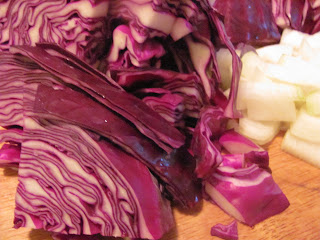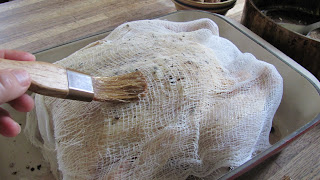But, this project is not bound by weather conditions or personal taste - it's mission-driven - so, while these dishes may not have been my all-time favorites, I've certainly learned some things about the beautiful country of Germany and it's cuisine I didn't know before. Therefore, it's all good.
 For starters, I was given a copy of an original recipe for Rotkole (red cabbage) from my wonderful friend, business partner and frankly, one of the most interesting and eclectic people I know, Karen. Her grandmother, Mathilda Ramrath, was born in Germany in the early 1900's. Like so many immigrants, she came to this country in search of a better life.
For starters, I was given a copy of an original recipe for Rotkole (red cabbage) from my wonderful friend, business partner and frankly, one of the most interesting and eclectic people I know, Karen. Her grandmother, Mathilda Ramrath, was born in Germany in the early 1900's. Like so many immigrants, she came to this country in search of a better life. When the stock market crashed in the 1930's, Mathilda returned to Germany with her son, and left him to be raised by relatives where he would be properly cared for. She came back to the U.S and worked alongside her husband in a gas station, returning briefly to Germany in the late 1940's, but eventually came back to the U.S. with her son to live a long life, surrounded by friends and family. I am honored and pleased to be in possession of her recipe - in her original handwriting - which, by the way, I liked far better than the meatballs and spaetzle!
When the stock market crashed in the 1930's, Mathilda returned to Germany with her son, and left him to be raised by relatives where he would be properly cared for. She came back to the U.S and worked alongside her husband in a gas station, returning briefly to Germany in the late 1940's, but eventually came back to the U.S. with her son to live a long life, surrounded by friends and family. I am honored and pleased to be in possession of her recipe - in her original handwriting - which, by the way, I liked far better than the meatballs and spaetzle! Located in Central Europe and stretching from the Alps across the Northern plains to the North and Baltic Seas, Germany is known for many things. Among them, famous musicians, the Holocaust, world renound German engineering, the German shepherd (my favorite) and many other societal contributions. Needless to say, Germany's history is both remarkable and complex.
Located in Central Europe and stretching from the Alps across the Northern plains to the North and Baltic Seas, Germany is known for many things. Among them, famous musicians, the Holocaust, world renound German engineering, the German shepherd (my favorite) and many other societal contributions. Needless to say, Germany's history is both remarkable and complex.Most people equate German food with meat and potatoes, and while this is true, the focus on sweet and sour in many dishes is uniquely German. Moreover, cuisine varies widely from one province to another, with influences from Italy, Turkey and increasingly, Asian cultures. As in the U.S. pizza and cheeseburgers are popular fastfood staples.
 |
| Bacon, lean ground beef, bread, onion, anchovies and an egg make the meatballs |
 |
| Your hands are your best tools - combine as you would meatloaf |
 |
| Shape into 2" meatballs and cook in broth for 20 minutes |
 |
| Gravy made of butter, flour, capers, lemon juice, mustard and an egg yolk |
 |
| Cook cabbage with vinegar, sugar, cloves and a chopped onion |
 |
| Make the spaetzle: eggs, flour, milk, baking powder and salt |
 |
| Mix dough - add a little milk if too thick at first |
 |
| Force dough through colander with a rubber spatula - spaetzle drops into water and cooks |
 |
| German Meatballs, spaetzle and lemon-caper gravy |
 |
| Rotkole - lovely to look at and very good to eat |
These recipes are fairly long and detailed, so I am opting not to write them out...However both the spaetzle and the meatballs can be found at the following link: www.germanculture.com
Here's Mathilda's Rotkole Recipe
Red Cabbage - Rotkole
1/2 inch water in pan
Bring to a boil and add cabbage and one medium sized onion - chopped
1 tsp. salt
1/ cup vinegar
1/4 cup sugar
1/ tsp ground cloves
2 Tbsp. bacon fat (I used butter)
flour to thicken
That's it - that's all the direction you'll get because that's the way Mathilda wrote it!
Final Assessment: Very good hearty fare, better perhaps, cooked on a cool fall night! The Rotkole was rockin'













































